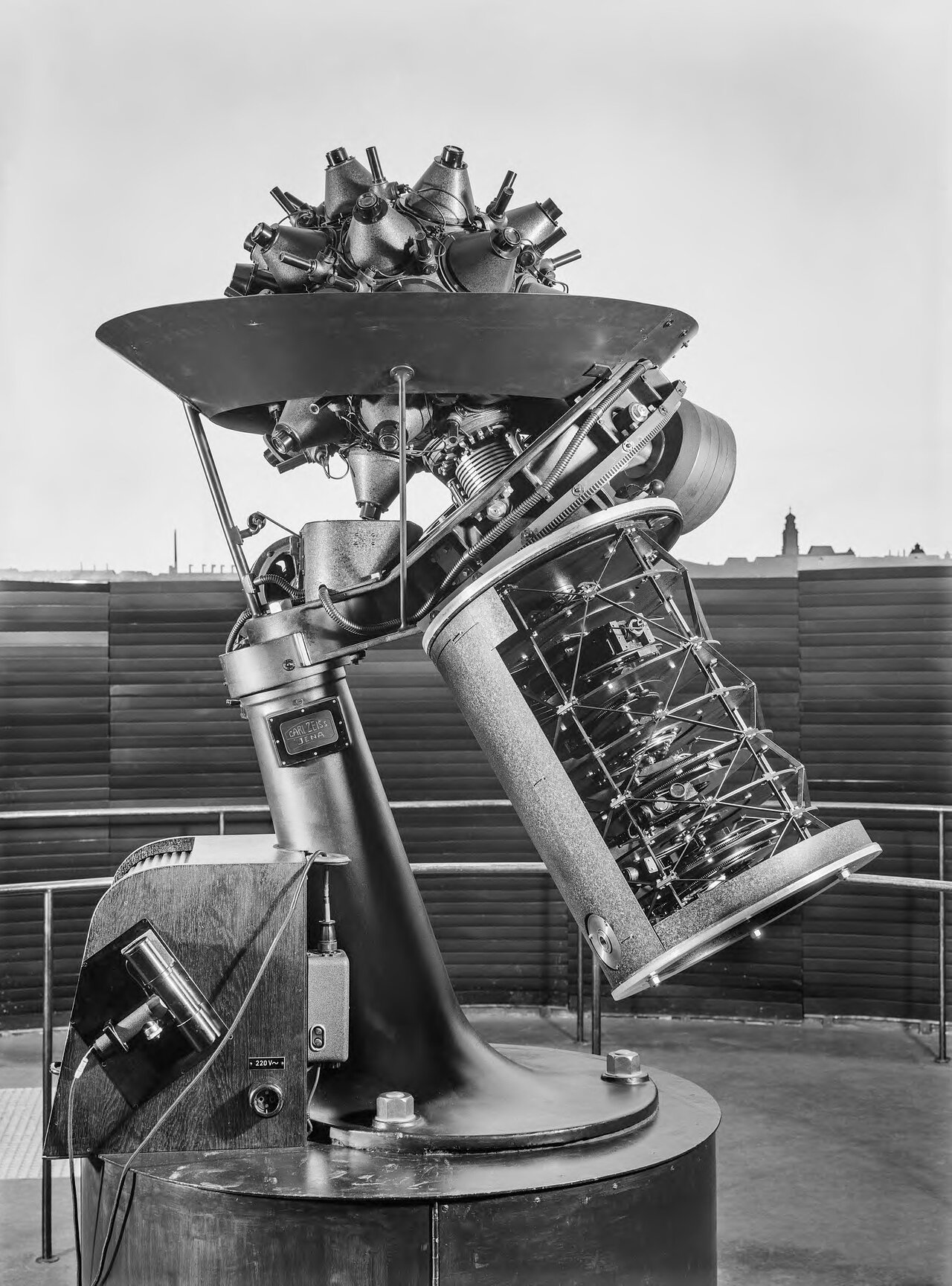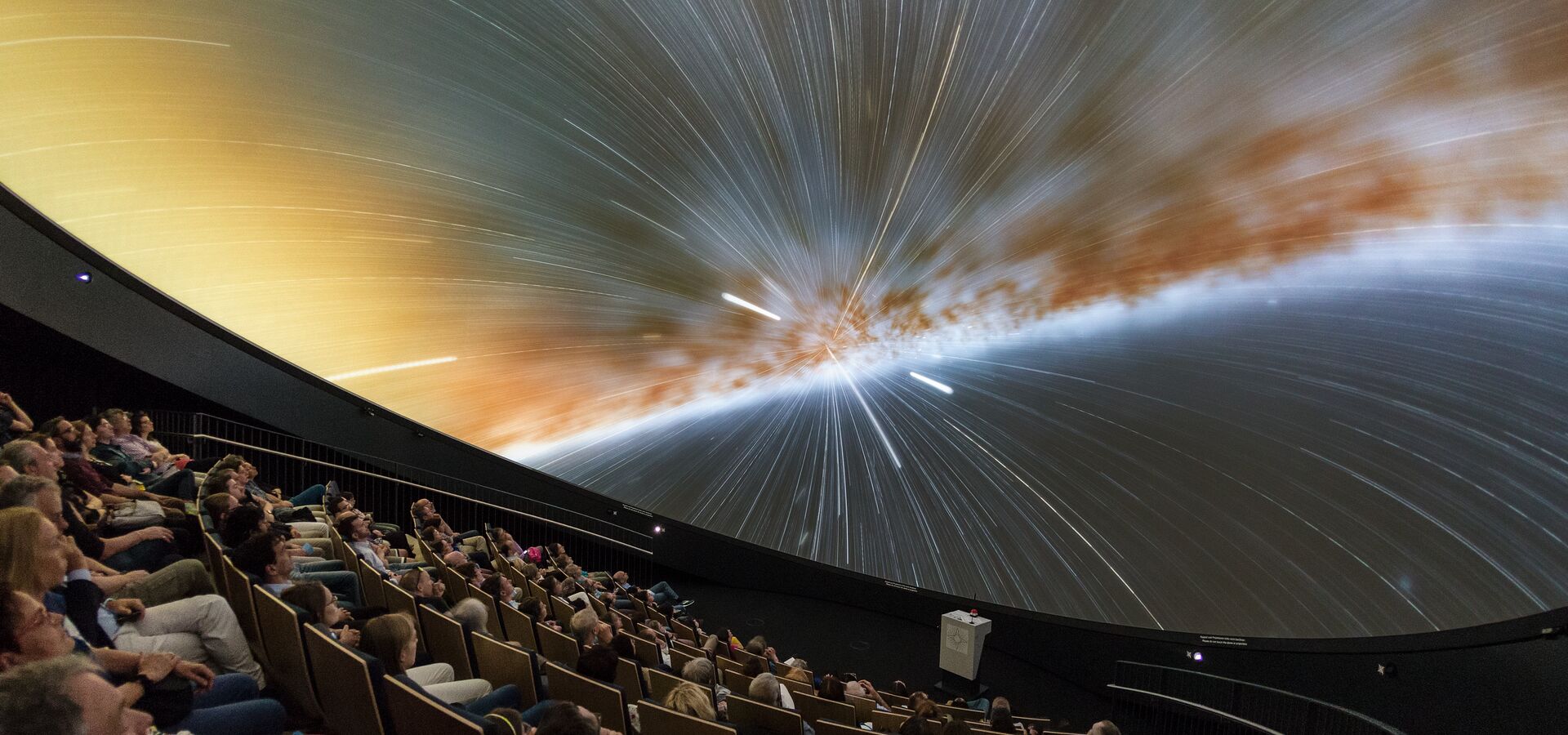- How planetaria have changed in 100 years
- What can be taught in a planetarium to different audiences
Humanity has spent its whole existence looking up to the stars, often trying to bring them down to Earth. From cave paintings and oral stories, to astronomical clocks and orreries – we've tried to capture and learn about the Universe in many ways over thousands of years. One hundred years ago, on 7 May 1925, one invention completely revolutionised the way we share our astronomical knowledge.
On this day, the first projection planetarium as we know them now, opened at the Deutsches Museum in Munich (not too far from ESO Headquarters in Garching), giving the public a brand-new opportunity to engage with astronomy in an accessible and immersive way.
Their original planetarium projector model, which was first demonstrated to the public about 18 months earlier in the German city of Jena, illustrated the movement of 4,500 stars along with the Sun, Moon, and planets. At the time, there wasn’t a whole lot of content to deep dive into beyond these objects; astronomers hadn’t yet discovered a planet outside the Solar System, and were only just starting to realise that our galaxy is just one among many! Since then, there have been many more discoveries made, and plenty of developments in the over 4000 global planetaria operating today.
So, what is it about the planetarium that keeps us coming back a century later, and what might they look like in another 100 years’ time?

Working with planetaria
According to Tania Johnston, Head of the ESO Supernova Planetarium and Visitor Centre, people love planetaria because they can’t find the experience anywhere else. “It’s a wow factor,” she says. “It’s got the opportunity for capturing people’s attention just because it’s so amazing to be able to see the Universe around you.”
Before joining the ESO Supernova, Tania worked for the Royal Observatory Edinburgh, where instead of presenting to school groups in a fixed planetarium at the Observatory, she would bring a blow-up planetarium to them. “We had a standard show that we would run. Along the way, you sort of developed and added extra bits and had some fun,” she says.
Of course, this mobile planetarium had the benefit of being able to reach audiences that wouldn’t necessarily have the capabilities to travel, but it also presented its own challenges. “The equipment was quite heavy, so you knew you would get your workout done when you’re going around the country with a mobile planetarium.”
The shows consisted of kids sitting in a small blow-up dome, with a projector that had fixed points of light to represent well-known stars and constellations (similar to the first projector model in the 20's). Squeezing in around twenty five children at a time, Tania and her team would run eight shows in one day just to get through a whole school. “Whereas here at the ESO Supernova, it’s just come in, switch on the computers and the projectors and it’s ready!”
The ESO Supernova is a permanent digital planetarium which runs about 600 shows a year. It uses five projectors that each have their own computer, controlled by a main computer in the centre of the theatre. As explained by ESO Supernova Technical Coordinator, Álvaro Almeida, this setup combines all of the images into one seamless experience across the 14-metre dome. “It’s a special projector in a sense that it works differently, but it’s like any projector you have in a school class,” he says.
Due to the digital nature of most modern planetaria like the ESO Supernova (or LED domes like the Las Vegas Sphere), there is no limit anymore to the content they can show. There are so many free and accessible full-dome shows out there, ranging from topics on light pollution, all the way to an exploration of dinosaurs.
Tania’s favourite shows are the free to access ones produced by ESO, which often include zooming into far-off galaxies. “It's pretty cool to be, you know, flying through the Universe.”
What to teach in a planetarium?
Most visitors to the ESO Supernova are families with school-aged kids. Given their audience, Tania says most of the shows they run are catered to this younger demographic. The younger shows go through things like what night and day are, a little bit about the planets, and more. But there are also some much more in-depth shows for older audiences that touch on the technology developed by ESO, and the research that is undertaken with our telescopes.
“We try to have quite a varied program, and make sure we have something for almost everyone,” she says. “The most challenging shows are actually when we get requests from the people that are here having conferences,” referring to the scientific conferences that we regularly host at the ESO Headquarters. “But in the planetarium, everything we have is geared to the general public. So that’s often interesting to try and find something to match that audience.”
One of the main goals for Tania is for the audience to gain some practical knowledge. “We want everyone to come away with some understanding of what’s going to be in the night sky locally, so they can go outside and think oh, I remember in the planetarium they said that this bright point of light was Jupiter!”
Connecting with community
For places around the world that have a hard time seeing the night sky, planetaria have proven a very powerful tool. As Sofía Otero, ESO Outreach Officer in Chile says, “here in Santiago, you cannot see any stars anymore... the sky is so polluted by light, you can rarely see more than five objects.” This is disheartening, considering that Chile is home to some of the darkest skies in the world.
She recounts how her 19-year-old daughter was surprised when she learnt that there are more stars hidden behind the light pollution. “We [the scientific community] take the knowledge for granted... it’s understandable others are not aware that you could see the stars if you just turn off the lights,” Sofía says.
In her role, Sofía has had the opportunity to support planetaria in Santiago and the surrounding region with shows that include information about ESO and about their own local skies. “The planetariums have this responsibility to promote dark skies,” she says as she describes one of the shows that flies over the city of Santiago, demonstrating how it would look were there no light pollution.
To Sofía, it’s also important to highlight the work done at ESO. She says, “the communities of Antofagasta and Coquimbo — from the places where the ESO observatories are — are not really aware that they exist.” By raising awareness of ESO's work, these shows offer an opportunity to bring a much wider community to the table.
Looking beyond the dome
For Tania and the ESO Supernova, the future of planetaria is becoming more inclusive. “I really want to keep improving the accessibility of our planetarium,” she says, as she speaks about others introducing things like sign-language interpreters, or haptic technologies to simulate tactile sensations. To create a more accessible planetarium, she makes sure to stay connected to the broader community, and to the people working in planetaria around the world. “It’s really cool working in a planetarium, and the community is lovely,” she says. “They [planetarians] are all just so passionate about what they do.”
In terms of the technology used in the ESO Supernova, Álvaro stays in constant contact with other technical leads from different planetaria. “We stay up to date with the technologies and seeing what other planetariums do because we also want to offer the best.”
Through Sofía’s experience, we can see the role of planetaria is changing. As a space that continues to inspire people, there are more opportunities to use these areas in ways that might not have been expected back in 1925. “I've grown up with the idea that planetariums are only for stars,” says Sofia “and now it’s stars and more. It’s music, it’s culture, it’s a meeting point.”
Links
Biography Amy Briggs
Amy is a recent science communication graduate from the Australian National University. Before coming to learn from the COMMS team at the ESO, she worked for the Australian Academy of Technological Sciences and Engineering (ATSE) as a Communications Coordinator and as an Editorial Coordinator for the youth magazine Careers with STEM.
She has also written for the Sunday Space column in The Canberra Times, ABC Science, and the CSIRO’s Double Helix magazine.
She has a passion for storytelling, reading, and unihockey.




